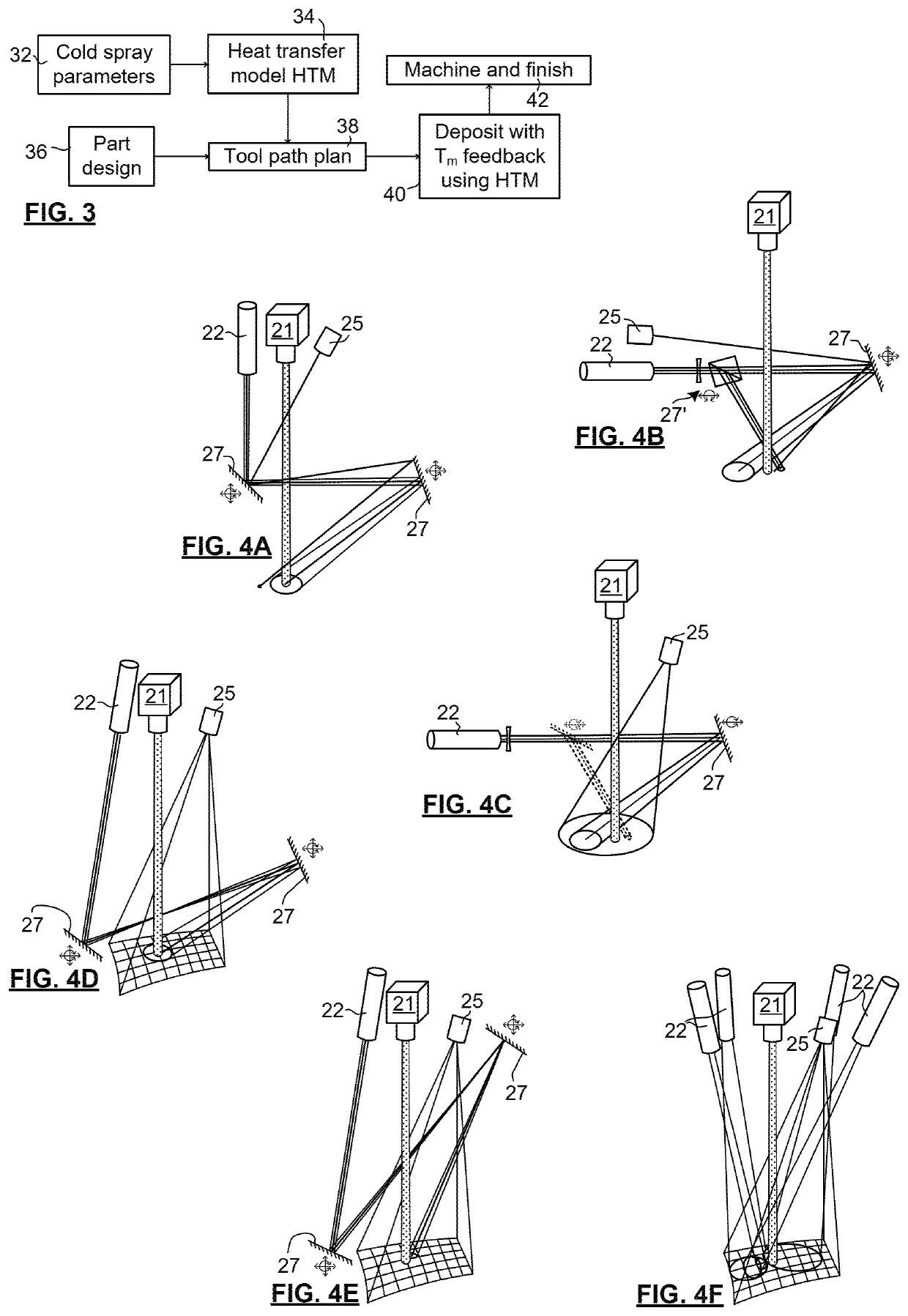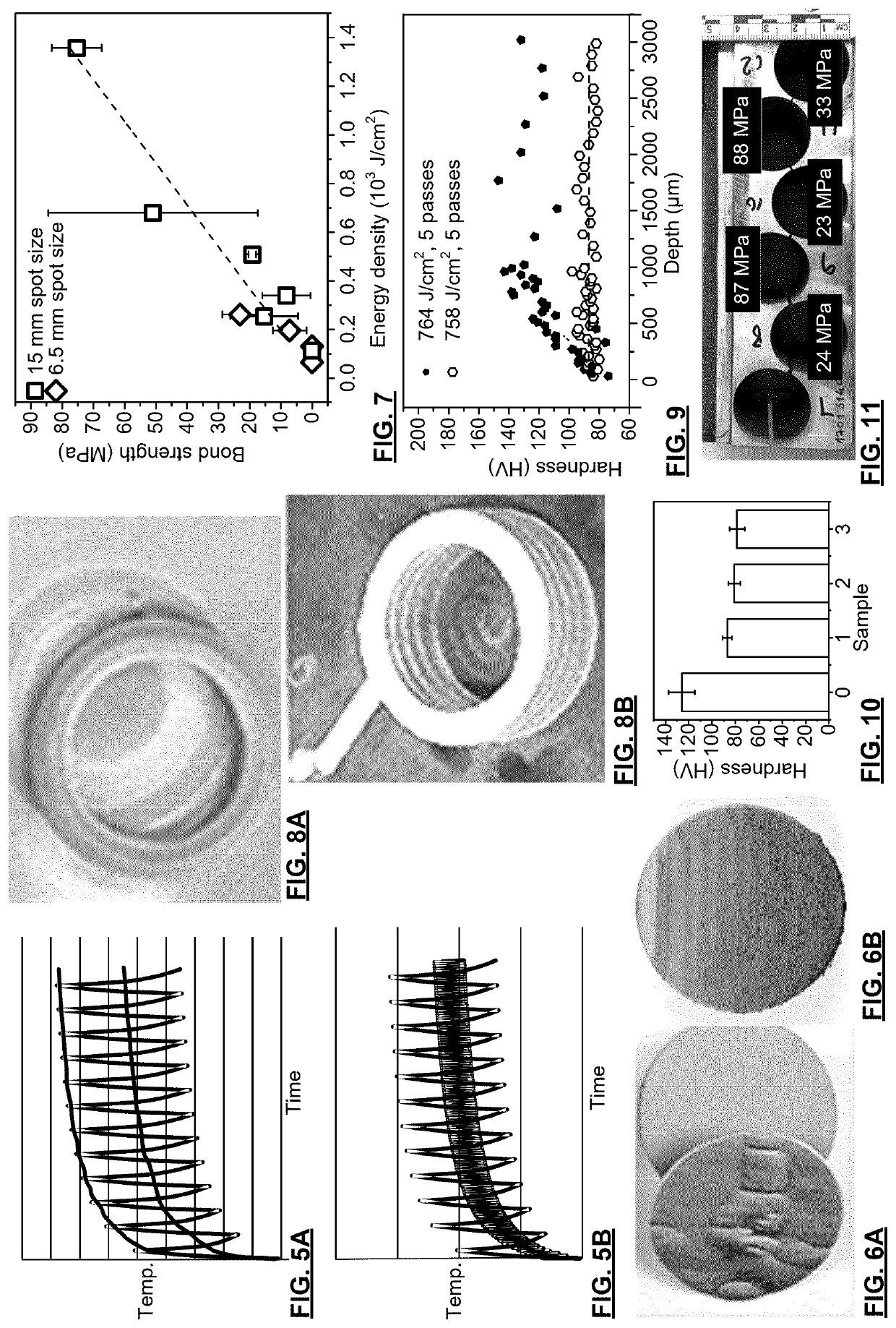Apparatus and method for temperature controlled cold spray
a technology of temperature control and apparatus, applied in the direction of heat inorganic powder coating, coating, additive manufacturing, etc., can solve the problems of increasing the difficulty of thermal control to establish consistent thermal environments for the cold spray process, complicated model heat shedding, etc., to improve the deposition properties, improve the temperature control, and improve the effect of deposition properties
- Summary
- Abstract
- Description
- Claims
- Application Information
AI Technical Summary
Benefits of technology
Problems solved by technology
Method used
Image
Examples
example 1
Copper CS Deposition on Circular Plates
[0104]FIG. 6A is a photograph of a delaminated copper coating that was CS deposited onto a mild steel substrate deposited without laser assistance. FIG. 6B is a photograph of a copper coating deposited on the same substrate with continuous laser assistance. Both coatings were produced using Inovati™ (Santa Barabara, Calif.) low pressure CS gun using nitrogen at 300° C. and 90 PSI with the gun traverse speed of 10 mm / s. The surface of the samples were grit blasted using alumina grit 60 particle in preparation for the deposition. In depositing the coating shown FIG. 6B the first pass used a laser beam spot size (at surface) of 6 mm and power of 750 W. Subsequent passes did not have any laser assisted heating. The adhesion improved as the coating remains on the coupons after deposition. Visual inspection showed that the coating is oxidized (darker color).
example 2
Power Density Vs Bond Strength
[0105]A study of the effect of power density of continuous lasers on bond strength of coatings was performed. Coatings were produced by cold spray of commercially pure copper powder using Plasma Giken™ PVS-800 gun at 800° C. and 4.9 MPa pressure Nitrogen. A stand-off distance of 30 mm was used for the cold spray gun. The laser power varied and two lasers were used one 4 kW and one 1.6 kW. Laser spot sizes were 6.5 and 15 mm. The laser and the cold spray gun were mounted on the same robot and the displacement velocity (10 mm / s and 300 mm / s) were varied. Overall, increased energy density leads to improved adhesion, as seen in FIG. 7. The effect of surface temperature is noticeable. Even with 4 kW power at 300 mm / s, there is no adhesion of copper to the mild steel, but at lower speed (10 mm / s), even with lower (1.6 kW) power, the bond strength exceeds the test capabilities, and it is a glue that fails before the coating delaminates.
example 3
Pulsed Laser Vs. No Assisted Heating Surface Adhesion of AM Rings
[0106]FIGS. 8A,B are photographs of CS additively manufactured part (ring) adhesion on a mild steel substrate by cold spray. In these tests, AM rings were placed on mild steel substrates and cold sprayed along their interface in an effort to join the rings to the substrates. To improve adhesion, the mild steel substrate shown in FIG. 8A was grit blasted using grit 24 alumina, but the substrate was not grit blasted in the example of FIG. 8B. In both cases, cold spray was deposited with a zigzag pattern with 1 mm step size. The traverse speed was 50 mm / s. The cold spray jet from the Inovati gun was about 480° C., and 120 psi. The stand-off was 15 mm giving a laser spot size of about 6 mm. Both the particle jet and the laser jet were supperposed. The embodiment of FIG. 8B was different only in that the substrate was not grit blasted (used as-received), and for the 1st pass only a 4 kW, 10 Hz, 10 ms (400 J / cm2) pulsed lase...
PUM
| Property | Measurement | Unit |
|---|---|---|
| Time | aaaaa | aaaaa |
| Time | aaaaa | aaaaa |
| Time | aaaaa | aaaaa |
Abstract
Description
Claims
Application Information
 Login to View More
Login to View More - R&D
- Intellectual Property
- Life Sciences
- Materials
- Tech Scout
- Unparalleled Data Quality
- Higher Quality Content
- 60% Fewer Hallucinations
Browse by: Latest US Patents, China's latest patents, Technical Efficacy Thesaurus, Application Domain, Technology Topic, Popular Technical Reports.
© 2025 PatSnap. All rights reserved.Legal|Privacy policy|Modern Slavery Act Transparency Statement|Sitemap|About US| Contact US: help@patsnap.com



